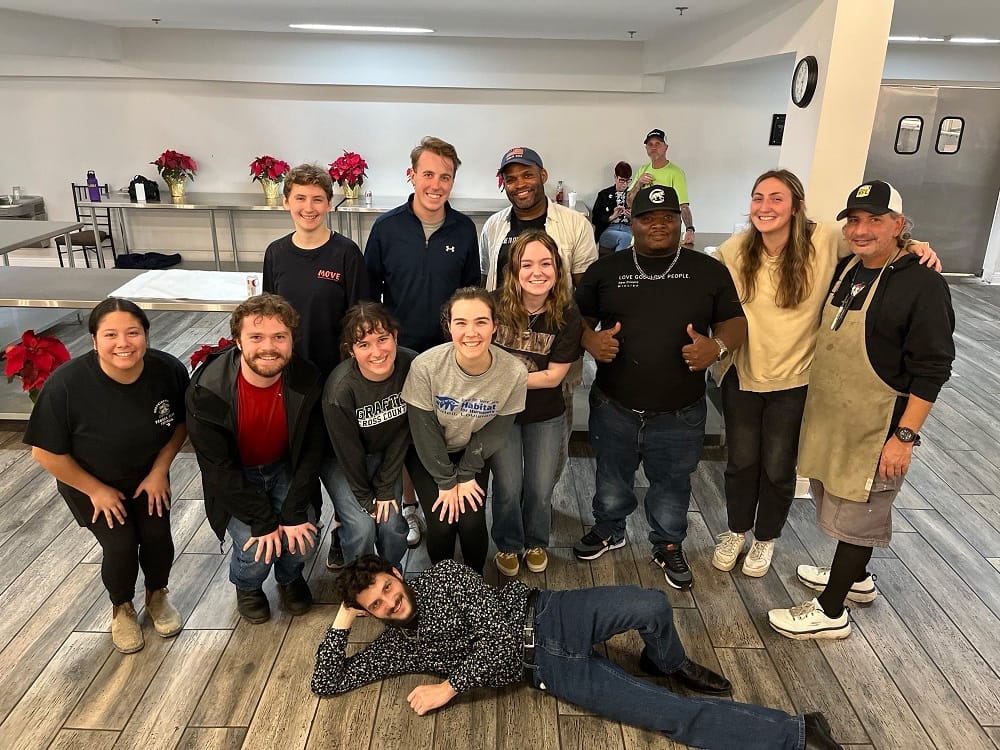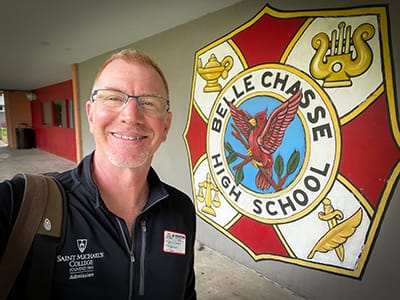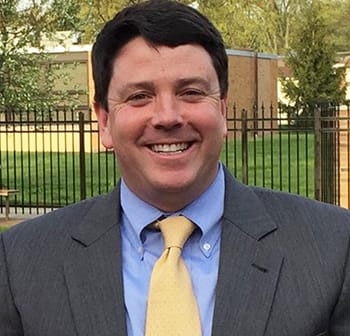Faculty artist showcased at Fleming
Fleming exhibit no small thing for faculty artist Brian Collier
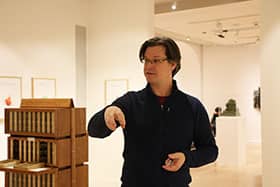
Directly above, Collier speaks in the midst of his Fleming display — the cabinets behind him contain some of the collection’s objects, with enlarged photographic prints of some of them on the walls behind him. Views below show patrons and Collier at the exhibit, with the bottom image showing the entrance to the section of the Fleming where these items can be found (photos by Eva Wilton ’19)
The objects that are his focus might be small, but artist Brian Collier’s contribution to a current Fleming Museum exhibit at the University of Vermont is a big moment for the Saint Michael’s College fine arts professor and his growing reputation for creative, awareness-raising experimentation in art-making through a host of media.
When Collier heard this past year that Fleming curator Andrea Rosen was ready to move forward on an idea she’d mentioned to him years before — to assemble a “miniatures” themed exhibit — he knew that his by-now well-established “Traveling Museum of Very Small Objects,” conceived and launched in 2004 under a different name, was a perfect fit to be part of the larger exhibit.
The response of museum patrons in the first three weeks to Collier’s contribution has exceeded his best expectations, the artist said of this exhibit that will be at the Fleming through May. His intentionally thought-provoking and ever-evolving participatory installation, based on the so called “Collier Classification System for Very Small Objects” (namely, anything that someone can fit in one of those little glass vials common in science labs — no more than 25 millimeters, roughly an inch) has received more than 100 submissions of new “small objects” from patrons in the first three weeks.
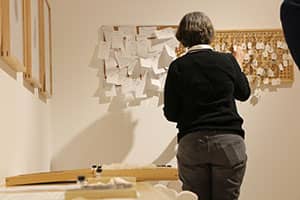 “That’s by far the best I’ve gotten” for exhibits of his traveling museum, which has shown around the U.S. and even in Germany in recent years, he said. The range of very small objects nearly defies categorization — were it not for Collier’s classification system that ties them together through a whimsical but logical nomenclature that he just made up. “It’s a mish-mash of whatever—paper clips, bits of electronic devices, lint, dead bugs, little pieces of food and candy – you know, people will bite an M&M in half so it fits!”
“That’s by far the best I’ve gotten” for exhibits of his traveling museum, which has shown around the U.S. and even in Germany in recent years, he said. The range of very small objects nearly defies categorization — were it not for Collier’s classification system that ties them together through a whimsical but logical nomenclature that he just made up. “It’s a mish-mash of whatever—paper clips, bits of electronic devices, lint, dead bugs, little pieces of food and candy – you know, people will bite an M&M in half so it fits!”
He said the Fleming show amounts to a culmination of his recent sabbatical, which he largely spent expanding this project along with others. Collier’s other consuming passion at the moment is an exhibit he already has presented at the Shelburne Museum and other places, titled “Unlawning America,” which explores the positive environmental impact resulting when lawns are left un-mowed and are absent of herbicides and insecticides. It further explores how society can help the ecosystem through active passivity.
Collier’s Traveling Museum lives primarily in his North Campus Sloane Hall office, unless it is traveling for an exhibit. He has crates suitable for shipping it anywhere at a moment’s notice. “Sometimes I get invitations, sometimes I sent out inquiries,” he said. The collection centers on items in the small one-dram glass vials. It’s ever growing as viewers suggest and submit new items for the artist to catalogue and place in the collection.
The artist stresses that at the Fleming he is just one part of a group show with eight or nine other participating artists featuring all sorts of miniatures in a variety of categories. “A whole half of the museum is filled out with all of our works,” he said. “It’s a great show and I really feel honored to be part of it.”
Unlike most occasions when it travels on its own, Collier’s exhibit this time at the Fleming includes about 15 framed large-format photographic prints that he made of the collections’ small objects. He photographs, processes and places into the master collection each new “vial” addition to the collection, preserving each in mineral oil.
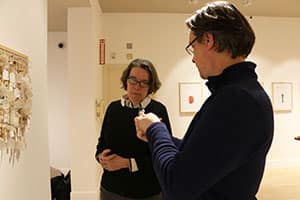
Collier’s original motivation for the “Small Objects” project that’s now at the Fleming grew from his interest in the structural history of natural history museums. “I came across a fascinating history of how the first universalized classifications systems came to be,” he said, explaining that many of those systems that emerged are Latin-based, while Collier’s small-object nomenclature is English-based.
He describes his system as an “Anglicized trinomial nomenclature,” using English word fragments as building blocks. “I was interesting in making a project that basically got people to really look at things and notice things in their landscape – an exercise to make you slow down and really look.” That’s one of the key jobs of art in his opinion: “to get people to look at things so deeply that you really see what’s in front of you – it’s a skill you have to learn.”
Collier said it also interested him that in natural history collections, “the items are so far removed from their original context,” which struck him as a “weird approach” to studying them. “I was interested in what that shift of context does to our understanding of the natural world; I also was interested in display structure and the element of the control of our environment,” he said. “Also, this is about the joy of meticulous collections and the visual impact of that.”
It’s nearly a given for artists to have collections in their body of work, and Collier said he long has been a collector of one thing or another. One point he asserts in the show is that scientific naming systems are not as objective as many people think they are just because the Latin names sound so official and formal “There’s a lot of subjectivity in there,” he said, “so I point to that and challenge the implicit objectivity by making my taxonomy extremely subjective. People get a little upset at the level of subjectivity!”
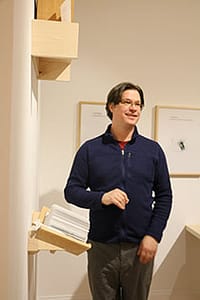
He accepts everything that people submit, the only limiting criteria being that it fits in the vial and did not involve killing a living thing — though he accepts already-dead bugs and takes submitters at their word. “I also don’t take liquids or gasses” he adds.
Saint Michael’s students have benefited for many years by helping their professor with this project in its various aspects as they learn about the professional art world. “Students learn that just the managing of getting new exhibitions is a whole job in itself — so I teach professional practices in our studio class – the nuts and bolts on how to start doing it.”
At the Fleming currently he has a rack up on the wall for viewer submissions — “and they say it’s getting full.” This will be part of the display at future showings too. Once he gets a contribution, he said, “I log the name, photograph the object in high-resolution, then preserve all the specimens with mineral oil. Part of the project is that they have to be visible to the human eye or can’t be included.”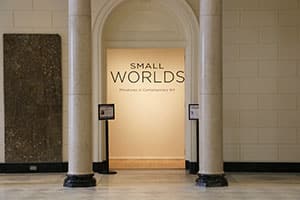
He has greatly enjoyed watching people interact with and focus upon the Small Objects exhibit at the Fleming. The display there invites people to build new names if his charts don’t seem to have enough descriptors; and he always welcomes new suggestions for the ever-growing collection. “I have built a really collaborative relationship with the audience on expanding this,” said Collier, who envisions that it might continue to expand indefinitely.
